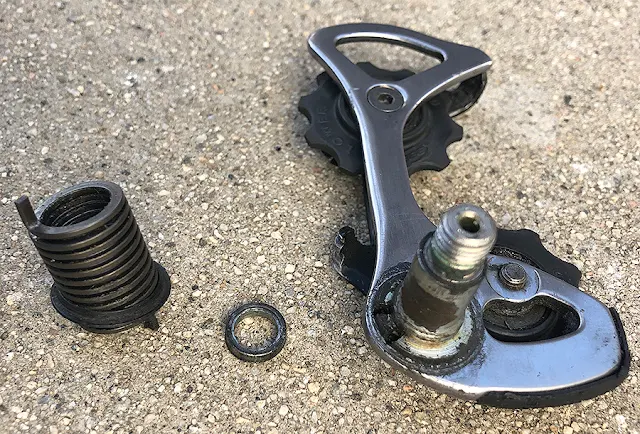This happens to me quite often.
The starting assumption (in this case suspecting the derailleur & it's adjustment) is often wrong. I'm not sure if the course would have been any different on this one, even if I didn't suspect the derailleur to start...
Thought it might be the derailleur jockey wheel carrier being a bit loose at its pivot point.
Took it apart.
The arrow points to the hole where the tip of the rotational spring is keyed to.
Didn't see any problems inside...
Took it apart & still didn't see any obvious issues...
The piece in the middle is a "spacer" that goes where the threads on the piece on the right goes.
The spacer had some wear on it but when it was all put back together, the amount of play didn't seem to change much.
The amount of play was pretty small to start with so I may be on the wrong track.
I put everything back together and went for a test ride with no change...
Looking at the gears on the rear cassette, the third gear from the top was one of the gears that I had the "skipping" issue the most with.
Taking a closer look at the gears & the teeth on the third gear, it appears that the shape of the depresses area appears to be "stretched" instead of being closer to a half-round shape.
Measuring the space between the teeth (not super precise because I'm just using the sharp tips of the caliper to estimate the tips of the gear teeth), the third problem gear has a gap around 0.42 inches.
Compared to the second to the smallest gear's teeth spacing, the distance is much smaller; closer to 0.385 inches.
Also, the shape of the space between the teeth looks much more like a half-round.
I happen to have another set of complete used wheels (with tires/cassette/skewers) that fit the bike.
I swapped the rear wheel onto the Cannondale & went for a test ride.
No problems.
It all makes sense.
With the old worn out chain, the gap between the links is larger when the rollers in the chain are worn and the pivots are worn.
Thus, with a worn chain & worn gear, they compensate for each other.
When I installed the new chain, and used it on the worn gear, the gaps are now incompatible & thus the chain can basically skips off the tooth when significant torque is applied.
First time I've dealt with worn out gear(s) on a cassette.
I'm guessing that I've put about 10 to 15 thousand miles on the bike since I bought it used (don't know how many miles before I bought it...). Where I ride, with lots of sand and moist salt air, doesn't help either.
One thing I should do is clean the chain more frequently and only use dry lube. Over the last couple of years, I've used a wet lube for the chain. It doesn't shed dirt and the wear accelerates.
Live & learn...
This is the cassette on the spare "Look" brand wheel.
It's also a Shimano 10-speed cassette.
I can just swap the cassette from the Look wheel to the Mavic Ksyrium wheel, or I can buy a new cassette. Haven't decided which way to go yet...
I have the right tool for removing the worn out cassette.
It's actually a pretty easy and fast job.
For now, I swapped the front wheel over to the matching one, so I can continue to ride.
The two outer ones are the Mavics that came off the Cannondale. In the middle is another spare rear wheel I have with a 10-speed cassette.
The wheel is a Campagnolo and the 10-speed cassette is also Campagnolo. I've read that Shimano & Campagnolo components generally don't mix but I've also read that sometimes they do and work OK.
May try this wheel to see if it works, for curiosity...
The tool to remove the cassette is different to the one for the Shimano. The locking outer ring is stamped "Campagnolo."















No comments:
Post a Comment